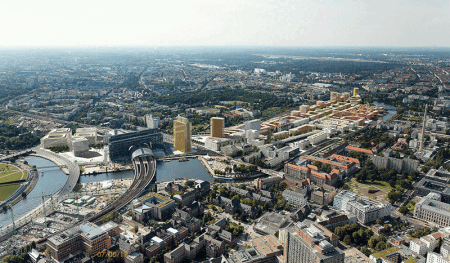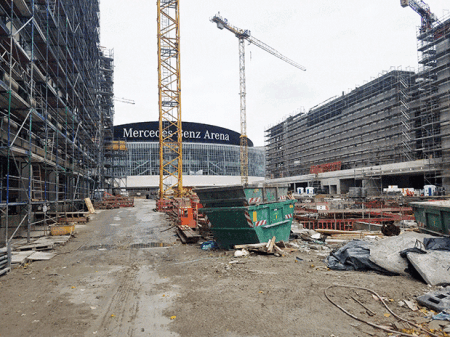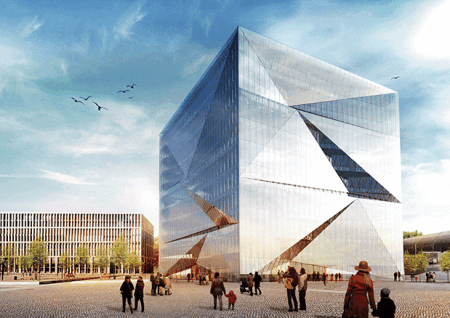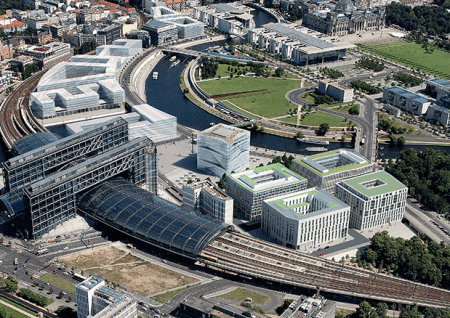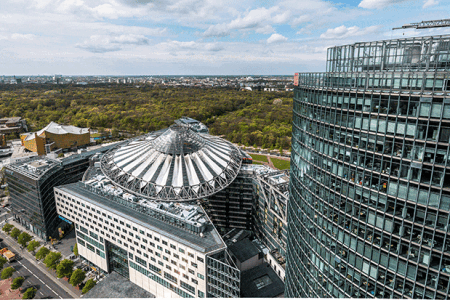For decades there was a dark hole in the center of the map of Berlin, a hectares-long stretch of old buildings and abandoned fields. Adolf Hitler wanted to build his Grosse Hall here, his dream of a Pantheon-like structure able to hold 180,000 people. After the war, the Berlin Wall sliced through the land, turning the empty landscape into one more casualty of the Cold War.
“Berliners have always known it as a no-man’s-land,” says Matthias Schmidt, head of German development for CA Immo, as he walks a visitor around the property. “Nobody wanted to go here.”
Austria-based CA Immo is developing 40 hectares (99 acres) on the site as Europacity, one of the largest mixed-use projects in the city. Designed around the Berlin central train station, which opened in 2006, the project is attempting to create a new city center for the long-divided city. With the train station as the hub, more than 750,000 square meters (8.1 million sq ft) of office, hotel, and residential space is planned for the project, which borders the Spree River.
Europacity’s timing could hardly be better. Demand for office space is soaring as Berlin turns from emerging market to bona fide hot spot. For the fourth year in a row, Berlin tops the Markets to Watch list in ULI/PwC’s Emerging Trends in Real Estate® Europe because of its strong fundamentals. “While values are high in all of the main European cities, in Berlin they are widely considered to be sustainable, buoyed by rapid population growth and vigorous business expansion, with the technology sector at its forefront,” Emerging Trends reports.
Demand is strong across all sectors, rents are rising, and valuations are hitting record levels. In October, Canada-based Oxford Properties paid €1.1 billion (US$1.3 billion) for the 17-year-old Sony Center on Potsdamer Platz, sending a clear signal that Berlin is attracting a new level of attention from international investors.
Europacity sits between two of the hottest markets in Berlin, the upscale former east neighborhood of Mitte and the fashionable western district of Charlottenburg. For a city still feeling the impact of decades of division, the symbolism is not lost on the Europacity developers. “We want to create links between the old and new,” Schmidt says.
Tech Companies and EntrepreneursThe scars of war and the wall are visible almost everywhere in Berlin. Disjointed neighborhoods are a hodgepodge of functional but uninspiring buildings, often constructed in the rush to create housing and offices for a city destroyed by war. When the wall came down in 1989, construction focused on the reemerging east part of the city, bypassing many neighborhoods in the west.
For many years the office market in Berlin languished, with a wealth of supply and little interest from international companies. Frankfurt, Hamburg, and Munich boomed, but Berlin was the rare major capital with no clear driver for business growth. That changed in recent years as more technology companies and entrepreneurs began taking advantage of Berlin’s low rents and cool vibe. Apple, Google, Microsoft, and Amazon are among the tech giants that have established a large presence in the city, now host to more than 2,500 startups.
“In the last two or three years, we reached the point where the oversupply was slowly absorbed,” says Hendrik Kadelbach, team leader of office investment for JLL in Berlin.
Office vacancy rates have fallen to 3 percent in many areas, and rents have started to soar. After years of hovering around €20 per square meter (US$2.20 per sq ft) per month, prime rents are now pushing past €30 per square meter (US$3.30 per sq ft) in top markets, according to JLL data. “For a long time, that was unheard of for Berlin,” Kadelbach says.
The acceleration of activity in Berlin has been triggered by several organic factors, including a surging economy and steadily increasing population. The government estimates that the city of 3.5 million people will to grow to 4 million by 2025.
Whereas demand is strong across the industry—including in the residential sector, where more than 125,000 units are needed in the next few years, according to industry estimates—the office sector is attracting the bulk of interest from investors. The €4 billion (US$4.7 billion) invested in office buildings in the first three quarters of 2017 was more than double the amount invested in any other asset class, JLL reports. More than 706,000 square meters (7.6 million sq ft) of office space was leased during that period, the highest office take-up in ten years, JLL reports.
Despite the economic growth, relatively little large-scale development has taken place in the city. Speculative projects are still rare, with investors wary of the growth projections, analysts say. The skyline may be dotted with cranes, but that is deceiving, says Ole Sauer, managing partner of Knight Frank’s Germany office. “It’s already pre-leased mainly,” he says. The city will need more than 1.5 million square meters (16 million sq ft) of office space to meet current demand; only 150,000 square meters (1.6 million sq ft) of space were completed in 2017, his firm reports.
The current political landscape makes it difficult to build, says Michael Voigtlander, head of real estate research for the Cologne Institute of Economic Research. The city government is focused on increasing the stock of affordable housing, not offices. But even new residential projects are difficult to make financially viable, with land prices rising and government mandates requiring affordable units.
“Any kind of new development is regarded skeptically,” Voigtlander says. “There is always fear of gentrification and more disturbances and more traffic.”
Europacity is one of the few projects with a master plan in place, large amounts of space available for occupiers, and access to mass transit, analysts say. When Berlin’s long-delayed Brandenburg Airport finally opens—perhaps in 2018, officials say—it will be a quick 30-minute train ride to the main train station and Europacity.
“The benefit [of Europacity] is the centrality,” Kadelbach says. JLL moved its Berlin offices to the John F. Kennedy House, an office building in Europacity, in 2015. The proximity to the train station and access to the airport were key factors in the decision, Kadelbach says. “I think this will be one of our major districts” in Berlin, he says.
Europacity Master PlanCA Immo acquired the land for Europacity in 2007 as part of its €1.03 billion (US$1.22 billion) purchase of Vivico Real Estate, the company set up to manage the land holdings of Deutsche Bahn, the German rail company. Construction of the central train station in 2006 changed the dynamic of the area, Schmidt says. “Infrastructure is the engine of the development,” he adds.
The master plan for the project, which is also close to the government district and cultural institutions, calls for more than half the site to be set aside for public areas, including bike trails and a walkway along the canal that borders the property. Heidestrasse, the street running through the center of most of the project, is being redeveloped in a Main Street format, with wide sidewalks and bike paths.
The developer’s initial focus has been on office space and hotels. “We have to connect with the market situation,” Schmidt says. But it was not easy to convince office tenants and investors of the viability of the new district. “We had to prove the book value was stable and equal to the marketplace,” Matthias says.
The project picked up momentum in 2012 when a 16-story tower was completed for the Berlin headquarters of French oil company Total. That same year, energy company 50 Hertz announced plans to build a seven-story headquarters in the development, and three years later KPMG agreed to take 14,300 square meters (154,000 sq ft) in a new seven-story building.
Most of the initial construction has been located around the train station, where a total of 11 office and hotel buildings have been finished totaling 205,000 square meters (2.2 million sq ft), according to Knight Frank. Of the 147,000 square meters (1.6 million sq ft) of office space already completed near the station, only 5,000 square meters (54,000 sq ft) remains vacant, Knight Frank says. Another 225,000 square meters (2.4 million sq ft) is expected to be completed by 2019, including the Cube, a ten-story office building designed by Copenhagen-based 3XN Copenhagen. The giant box-shaped building, across from the train station, is being built by CA Immo for TH Real Estate, the institutional funds manager, which bought the project in 2016.
CA Immo is also a planning a 100-meter-tall (328 ft) tower near the train station, which would mark a new move into tall buildings for the famously low-rise city. High-rise development did not make sense when space was leasing for €20 per square meter (US$2.20 per sq ft) per month, but the calculations have changed with rents over €30 per square meter (US$3.30 per sq ft), Sauer says. “High-rise buildings are again on the agenda,” he says.
The next phase of Europacity will increase the focus on residential development, with more than 1,500 residential units under construction. The original plan was to emphasize condominiums, but the bulk of the units will be rentals, reflecting current market conditions, Schmidt says.
The market may already be saturated with luxury apartments, according to Voigtlander. “The market for luxury buildings is satisfied for right now,” he says. “There are not so many people who can afford it.” Meanwhile, rents are continuing to rise, with average asking rents for high-end apartments in central neighborhoods moving above €15 per square meter (US$1.65 per sq ft) per month, CBRE reports.
But it is a difficult landscape for both developers and investors, with communities wary of rising prices. Investors interested in buying properties and spending money on restoration in hopes of raising rents might find it difficult to get approval from the city, says Jürgen Fenk, joint chief executive officer of SIGNA Holding and chair of ULI Germany.
“If you’re a cowboy coming into Berlin and think you’re going to buy something and raise rents, it’s not going to happen,” Fenk says. “These days, it’s easier to build new residential rather than hoping to buy something and enhance the value.”
Sony CenterFrom the perspective of investors, the €1.1 billion (US$1.3 billion) purchase of the Sony Center by Oxford Properties was a game changer for Berlin. The complex, which includes a mix of office, retail, and leisure space, is nearly 100 percent leased, including tenants such as German rail company Deutsche Bahn and Facebook. In 2010, South Korea’s state-run National Pension Service had paid €585 million (US$693 million) for the 2.4-hectare (6 acre) Helmut Jahn–designed complex.
The Sony sale was a “very important statement for Berlin,” making it clear that Berlin can offer big deals, Kadelbach says. He calls the price aggressive, but “from the standpoint of a long-term investor, it’s a good investment in line with the current market.”
The deal followed on the heels of publisher Axel Springer’s sale in July of two core real estate assets for €755 million (US$894 million), including its Rem Koolhaas–designed headquarters, which is under construction. The buyers were Norges Bank Real Estate Management, the Norwegian sovereign wealth fund, and U.S.-backed Blackstone Real Estate Management. Through the first three quarters of 2017, Berlin was the second-most-active market in Europe, generating €9 billion (US$10.7 billion) in deals, according to Real Capital Analytics.
The Sony Center was the first major purchase in Germany for Oxford, the real estate arm of OMERS, one of Canada’s largest pension plans. Oxford is hiring staff and setting up a base to pursue more Berlin investments, says Paul Brundage, the company’s senior managing director of Europe. The Sony acquisition “gives us a chance to build a team on the ground in Berlin and drive performance out of that asset and also source new opportunities,” he says.
“We think there is still significant growth potential in office rents in buildings like Sony,” Brundage says. Rents in Berlin are “still significantly below other cities in Europe,” he notes.
While financial centers like Frankfurt and Munich might be the main beneficiaries in a post-Brexit Europe, “it’s not beyond the realm of possibility that Berlin could participate” if companies start to flee the United Kingdom, Brundage says. Berlin is attracting young, international companies that might want a base in the European Union, he notes.
“It is a very dynamic period of time,” Brundage says. “Companies are choosing cities on the back of where people want to work and live. We think Berlin is a very livable place.”
Long-Term OutlookNot everyone is convinced Berlin’s growth rate is sustainable over the long term. “The question is, will Berlin really catch up to other European capitals?” says Voigtlander. Demand may soften by 2020 when new projects will be completed, he says.
“You might see project developers who are too ambitious,” he says. Rising interest rates and Berlin’s slow-growth political landscape could stall development. “Despite the political framework, Berlin is growing, but I’m not sure if that will be the case for next ten years,” he says.
With valuation increasing, pressure is mounting on yields. Prime yields on office space were expected to fall below 3 percent by the end of 2017, down from close to 5 percent in 2012, JLL reports. “Most [owners] prefer to hold, so there is a scarcity of good assets on the market,” Fenk says. “To find good core is becoming very tough.”
But Fenk believes investors will continue to view Berlin as a desirable market. There is still growth potential, he says. “It’s not like Manhattan, where there is a limited amount of space,” Fenk says.
After a rocky start, CA Immo expects Europacity to be largely built out by 2023—“much faster than we thought, due to the strong market in Berlin,” Schmidt says.
Through the process, he has learned lessons about developing such a large-scale project in Berlin. “It takes time. Stay calm,” Matthias says. “If the market is not strong, you have to wait, and the time will come.”

